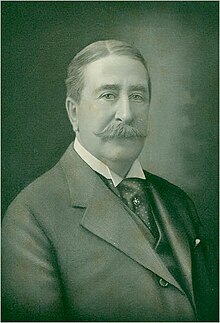Robert Henderson Robertson | |
|---|---|
 | |
| Born | April 29, 1849 |
| Died | June 3, 1919 (aged 70) Nehasane, Hamilton County, New York |
| Education | Rutgers College |
| Occupation | Architect |
| Spouse | Charlotte Markoe |
| Buildings | Pequot Library, Hammersmith Farm, Santanoni Preserve, 150 Nassau Street, Shelburne Farms |










Robert Henderson Robertson (April 29, 1849 – June 3, 1919) was an American architect who designed numerous houses, institutional and commercial buildings, and churches. He is known for his wide-variety of works and commissions, ranging from private residences such as Jacqueline Kennedy's childhood home Hammersmith Farm and the Adirondacks Great Camp Santanoni, great civic buildings like Southport's Pequot Library for the Marquand Family to some of the earliest steel skyscrapers in New York City.[2]
Robertson was one of the architects of choice for the late nineteenth century titans of industry, and designed several buildings for the extended Vanderbilt Family, including Shelburne Farms and the outbuildings at the Vanderbilt Mansion National Historic Site.[3]
- ^ Cite error: The named reference
macwas invoked but never defined (see the help page). - ^ "Robert Henderson Robertson (U.S. National Park Service)". www.nps.gov. Retrieved March 4, 2024.
- ^ Musso, Anthony P. "From horse and carriage to automobiles, Vanderbilt coach house served many uses". Poughkeepsie Journal. Retrieved March 4, 2024.